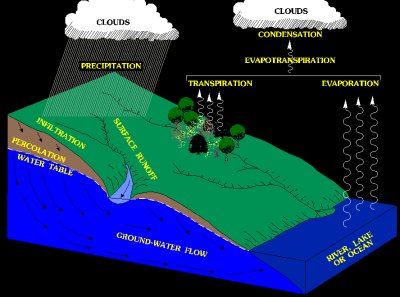- The sun is the primary source of energy for all hydrometeorological processes.
Evaporation and transpiration
- Solar energy evaporates water from the oceans (and a very little from the land). Plants add some water vapor to the atmosphere through transpiration. The water vapor condenses into clouds and finally precipitaiton, and most of it falls right back into the oceans, being as large as they are.
Precipitation
- Some of the clouds are transported over land, where their precipitation falls onto the ground. Most of that precipitation sinks into the shallow layers of soil near the surface (or onto plant surfaces), where it is used immediately by plants, animals, and people. Precipitation comes as rain, snow, sleet, ice pellets, dew, hail, and other types, but we will call it all "rain" from here on.
Runoff
- When too much rain falls onto the ground to conveniently infiltrate the soil, part of it "runs off". Gravity pulls it directly downhill. This runoff adds greatly to water levels in rivers and lakes. Occasionally, when runoff radically exceeds infiltration, it creates floods and flash floods.
Infiltration and percolation
- Water infiltrates the soil by moving through the surface. Percolation is the movement of water through the soil itself. Finally, as the water percolates into the deeper layers of the soil, it reaches ground water, which is water below the surface. The upper surface of this underground water is called the "water table". As you can see in the picture above, ground water can intersect with surface streams, it can appear at the surface as springs, and it flows generally downhill toward the ocean.
How long does all this take?
- The time scales for the various processes above to occur vary widely. The evaporation process from the ocean and land surface is continuous, but the formation of clouds can take anywhere from seconds to hours. It can occur for days. Generally, precipitation lasts from minutes to days, depending on whether there is a large source of atmospheric moisture feeding the system.
- Surface runoff of excess water can last from seconds to hours, usually. In large floods, the water may stay on land for days or weeks, as was the case during the Mississippi River flooding of 1993 and the Red River of the North flooding in 1997.
- Infiltration of rain into the topsoil usually starts immediately after the rain hits the ground and lasts until shortly after the rain stops. Percolation through the soil may take minutes or days, depending on soil type, and how wet the ground was to begin with.
Ground water
- Ground water moves veeeeerrrrrrry slowly, and a particle of water may take any where from days or months to years or even hundreds of years to move to the ocean, where it starts the process all over again. This is a main reason why ground water supplies are impossible to artificially replenish after being depleted. You can't turn on a hose and fill the ground up, again. Wells go dry because the pump used to bring up ground water no longer reaches the water table. A deeper well must be dug. "Effluent" streams, that is streams that intersect the water table (like the one pictured above) stop flowing. Ground water may take hundreds of years to replenish (through percolation) in particularly dry areas.
|

